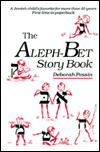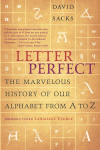
When I was a young kid, maybe third grade, someone gave me The Aleph-Bet Story Book
 Fast-forward to earlier this year. My father brought me Letter Perfect
Fast-forward to earlier this year. My father brought me Letter Perfect"What the he meant - and this is no kidding - was "Hey!" The letter's name indicated a shout of surprise. And the letter's shape illustrated it strikingly. The earliest surviving example of a written he appears oldest known alphabetic writing, carved into limestone in Central Egypt around 1800 BCE. The letter shape is a human stick figure, half crouching, perhaps leaping upward, arms raised at the elbows. The person is probably meant to be shouting, in an ancient Semitic expression that by coincidence resembles our "Hey!". "

You can see the development from the "hands-up" guy here to our current hey on the e-hebrew site.
There are those that say that hey actually refers to the Hebrew word הלל - hillul or hallel, meaning jubilation. I'm not so sure. While hey does start the word hallel, it isn't actually the make up of the word. In any case, I'm not sure we need to look so far. In Hebrew and Aramaic the words הא and הי (hey and ha) mean "behold". Klein says that הי, meaning "lo", "behold" or "here is" works as a prefix in the words הילך, היכן and הינו.
Interestingly, to return to Pessin, there are those that say that while the character originally meant hillul, it followed a similar transformation as we've seen in other letters, and later took on the meaning - and pronunciation - of "window". I don't think that this is referring to chalon חלון, since there isn't much of a similarity. Perhaps there was a Phoenician word hey meaning window. Anybody know?

No comments:
Post a Comment